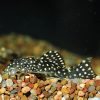No products in the cart.
The Gold Spotted Plecostomus (L-136) is a rare and highly attractive freshwater pleco that stands out for its beautiful golden spots spread across a darker body, creating a stunning contrast that makes it one of the most desirable ornamental catfish in the aquarium hobby. Belonging to the Hypancistrus group, this species combines beauty, manageable size, and peaceful temperament, making it an excellent choice for both experienced aquarists and those new to keeping exotic plecos. Native to the Rio Negro Basin in Brazil, the Gold Spotted Pleco thrives in warm, soft, and clean waters where it hides among rocks and driftwood during the day before becoming more active at night. These natural instincts are reflected in the home aquarium, where the fish enjoys plenty of caves, shaded spots, and a steady water flow to mimic its river habitat.
Unlike some of the giant pleco species, the Gold Spotted L-136 remains relatively small, usually reaching around four to five inches when fully grown. This makes it a suitable option for medium-sized aquariums starting at thirty gallons, though larger tanks are always preferred for the best quality of life. Ideal water parameters include a temperature range of seventy-seven to eighty-six degrees Fahrenheit, a slightly acidic to neutral pH between six and seven and a half, and good oxygenation with stable water conditions. Strong filtration and regular water changes are essential to maintaining the pristine environment that this species requires to stay healthy and display its best colors.
Feeding the Gold Spotted Plecostomus is straightforward and rewarding. While it may occasionally graze on algae or biofilm, it is not a pure algae eater like some other pleco species. Instead, it thrives on a mixed diet that includes high-quality sinking pellets, carnivore wafers, frozen or live foods such as bloodworms and brine shrimp, along with fresh vegetables like cucumber and zucchini. A varied diet helps maintain strong health, vibrant coloration, and natural activity levels.
This pleco is peaceful and fits well in community aquariums with other non-aggressive fish that share similar water needs. However, like many Hypancistrus species, it can be territorial with its own kind, particularly males, so aquarists should provide multiple caves and hiding spaces if keeping more than one. With the right setup, the L-136 can even be bred in captivity, as they are cave spawners. Males guard the eggs until they hatch, giving hobbyists a unique opportunity to raise their own generations of this fascinating fish.
Many aquarists ask common questions about this pleco, so here are a few quick answers. The Gold Spotted Plecostomus typically grows to about four to five inches, making it smaller and more manageable than many other plecos. It is generally peaceful and works well in community aquariums with calm tankmates. Its diet should be omnivorous with a mix of protein-rich sinking foods and vegetables. A thirty-gallon tank is the minimum recommended size, though larger aquariums provide a healthier and more stable environment. Finally, yes, they can be bred in captivity when provided with proper cave structures and stable conditions.
For aquarists looking for a striking, exotic pleco that is both beautiful and manageable, the Gold Spotted Plecostomus (L-136) is an ideal choice. It adds visual interest to the aquarium with its shimmering golden spots, brings peaceful behavior that complements a wide variety of fish, and offers the potential for successful breeding in home tanks. This rare pleco is not only a stunning showpiece but also a rewarding fish to keep for both beginner and advanced enthusiasts. To learn more about plecos and South American catfish care, you can explore detailed resources at Seriously Fish, a trusted site for aquarists worldwide.













Reviews
There are no reviews yet.